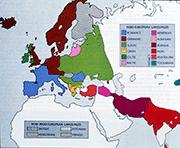E-Archive
Off the Beaten Track
in Vol. 16 - November Issue - Year 2015
Ancient Roots

Competing Hypotheses on the Homeland of the First Indo-Europeans

Distribution of Indo-European Languages
The light breeze blowing through the open window brought no relief against the scorching heat coming from outside. He frequently passed a damp towel across his forehead and around his neck as he hunched over the papers and books scattered across the large, heavy teak table. The sounds of an infinite number of birds and insects floated up through the air from the tropical forest surrounding the sprawling house. None of this managed to distract him, as his eyes darted back and forth between the books and notes that he had scribbled on numerous slips of papers. The similarities were astonishing and could not be the result of mere coincidence. He continued to work late into the night, trying to elaborate a theory that could explain it all...
*****
Although the ancient Greeks had noticed that their language had changed over the centuries, they did not dedicate any specific study to this issue. As for the Romans, once they had conquered Greece and had come into contact with the rich corpus of Greek literature, they became aware of similarities between Greek and Latin, but likewise did not pursue the matter.
It wasn't until the Middle Ages that scholars made their first feeble attempts to explain the morphological affinities that were apparent among most European languages and also between European languages and languages spoken on the Iranian plateau, such as Persian (Farsi), Pashto, Avestan and Kurdish.
During the age of the great sea voyages in the fifteenth and sixteenth centuries, considerable interest and curiosity were aroused by the unexplainable similarities among languages that were geographically very distant from each other. Merchants and scholars who travelled to India, such as Thomas Stephens and Filippo Sassetti, were especially surprised by the many words that appeared to have a common origin in Sanskrit, Greek and Latin, but also in other European languages. Some comparisons in English, Latin and Sanskrit: two/duo/dva; three/tres/trayas; seven/septem/sapta; nine/nove/nava; father/pater/pitar; mother/mater/matar; brother/frater/bhratar; widow/vidua/vidhava.
In 1686 the German scholar Andreas Jäger published a book entitled De lingua vetustissima Europae (On the Ancient Language of Europe) in which he hypothesized that in the remote past there had existed a language spoken in the Caucasian region which subsequently disappeared, but not before leaving behind groups of languages that included the ancestors of Greek, Latin, Germanic, Celtic, Slavic and Persian languages. Jäger was not familiar with Sanskrit and was unaware of the similarities with this language that previous observers had noted. Since the language mostly to the East with which Jäger was familiar was Persian and that mostly to the West was Celtic, he dubbed this hypothetical ancestral language Scythian-Celtic, Scythia being the name of an ancient empire located on the northern shores of the Black Sea that extended to the borders of Persia.
Following the British colonization of India, scholars had the opportunity of taking a closer look at Sanskrit, the sacred language of India. H.T. Colebrooke published A Grammar of the Sanskrit Language in Calcutta in 1805. These studies would subsequently lead to the birth of the comparative linguistics method.
In 1813, the Englishman Thomas Young first used the word Indo-European to indicate the ancestral language hypothesized by Jäger in 1686.
The study of Indo-European rapidly spread across Europe thanks to a speech that Sir William Jones gave at the founding ceremony of the Royal Asiatic Society of Bengala in 1786. Jones stated that "The Sanskrit language, whatever be its antiquity, is of a wonderful structure; more perfect than Greek, more copious than Latin, and more exquisitely refined than either, yet bearing to both of them a stronger affinity, both in the roots of verbs and the forms of grammar, than could possibly have been produced by accident; so strong indeed, that no philologer could examine them all three, without believing them to have sprung from some common source, which, perhaps, no longer exists." Jones was a judge at the Supreme Court in Calcutta who dedicated most of his free time and many of his nights to the study of Sanskrit.
What continued to escape scholars, however, was a scientific method to demonstrate that indeed these languages were related and that they came from a common ancestor. Noticing that words were similar in various languages was not enough, as these words could be so-called loan words that were taken by one language from another.
The breakthrough came at the beginning of the nineteenth century. The German Franz Bopp published a paper in 1816 that proved the fundamental similarities among the grammatical systems of the Indo-European languages. Rasmus Rask from Denmark published a work in 1818 (but written in 1814) that defined the systematic correspondence that must exist between two languages for them to be deemed related.
By Giovanni Gregorat, Contributing Editor MFN
Author: Giovanni Gregorat



























